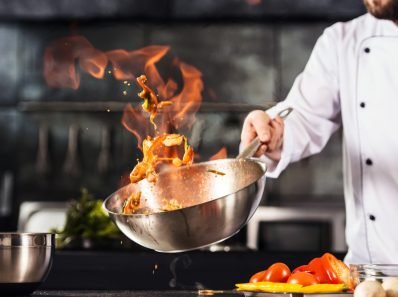Pasta is often hailed a quick and easy foolproof meal. It is a cupboard essential and weekly staple everyone can get right… or so we thought. Peri Eagleton, premium pasta brand expert of artisan Italian food company Seggiano, uncovers the many mistakes you might be making when cooking with pasta and offers her top tips on how to fix them.
1. You’re using too little water
Not cooking the pasta in sufficient water is a very common mistake, along with adding your pasta to the pot before the water is boiling. Using too little water can have disastrous effects as the starches from the pasta dissolve in the cooking water and, if the water to pasta ratio is too low, it turns into a cloggy gluey mess.
If you add pasta to water before it is boiling, it will tend to clog together because of the slower starch release into water which isn’t moving. Likewise, if you forget to stir it, pasta will tend to stick together.
You should always use 1.5 litres water per 100g of pasta. Drop the pasta into your briskly boiling water, stir and keep on a low boil for the time indicated on the packaging, stirring occasionally.
Pasta cooking time depends on several variables, so always do the ‘al dente’ test by carefully sampling a piece of pasta. It should be soft enough to bite through, but your teeth should still feel some resistance.
2. You’re not using salt, or adding salt at the right time when cooking
Have you ever made a basic glue with flour and water? The starch from the flour is similarly sticky and when you cook pasta you need plenty of water so that the pasta doesn’t get ‘gluey’.
Salt in the cooking water not only flavours the pasta, but limits starch gelation and so reduces cooking losses and stickiness. When cooking your pasta, be sure to bring the water to a brisk boil. Adding salt to water before it boils can slow down the boiling process, so add it once it has started boiling.
3. You’re not keeping your pasta moving
Many Italians add a spoon or two of the cooking water and a dash of a good quality extra-virgin olive oil when they mix in the sauce. The starchy pasta water helps to thin-down a sauce and add a boost of flavour without adding extra salt.
Also, many people think you should rinse pasta post-cooking, but if you drain it and leave it sitting in a bowl, it will start to stick together. Seggiano suggests adding your sauce and optional extra virgin olive oil immediately, stirring it and tossing it to keep it moving.
4. You’re using a poor-quality pasta
The quality of the pasta itself is genuinely important for our health and the gut in particular. Good quality and slow-dried pasta should look a little rough in texture.
The drying time and the temperature during the drying process makes a massive difference, because the grain is thermosensitive. Most industrial pastas use a quick and high heat drying process of 185 degrees at 3-4 hours, but this will strip the pasta of its nutritional value and degrade the quality and structure of the proteins.
Artisanal pastas – like the Seggiano range – are slow dried at a low temperature. A focus on provenance is key and Seggiano produces artisanal pasta using organic Tuscan durum wheat. Our pasta is bronze drawn, giving it a more porous, matte texture that binds flawlessly to sauces. It is very important that this is organic as non-organic wheat, especially that which is imported from Canada, is known to be high in glyphosate (a chemical compound used on crops), which is an established human carcinogen – a substance found to cause cancer in humans.
5. You’ve cooked it too little or too long
Your average packet of pasta will have the cooking time on it, follow the instructions and set yourself a timer to ensure you don’t overcook, or undercook, the pasta. It also helps to test the pasta regularly, so that you can gauge the firmness of the bite.
‘Al dente’ translates as ‘cooked so it is still a little firm to the bite’ and can be hard to master. Undercooked pasta will present as hard and indigestible, while overcooked pasta will become mushy or even slimy in its consistency.
You should always check the pasta about a minute before the packet cooking time is up to check whether it is firm to the bite, so that you don’t over or under cook it.
Remember that your pasta will keep on cooking after you drain it, as you toss it with a delicious pasta sauce and a spoonful of the cooking water in a pan, it will still be cooking. So factor this time in and drain your pasta 30 seconds to a minute early, so that the consistency is perfect when you come to serve it.
Peri’s ‘perfect pasta’ takeaway tips:
- Drain the cooked pasta over the serving bowl to heat it up.

- Perfectionists should note that pasta will continue to cook and soften just a little, even after it’s removed from the heat, so if you are tossing the pasta briefly in a pan together with the sauce, factor in slightly less time cooking in the water.
- Unsalted water boils quicker, so to save on energy, wait until your water is boiling before adding salt – and don’t be shy, add one handful of sea salt (or two tablespoons) for the best pasta flavouring and to limit starch build up. The pasta will only actually absorb around a quarter of the salt added, and the water should taste briny rather than overly salty.
- If you are going to eat the pasta with a sauce and want the two to perfectly blend together, stop boiling the pasta 1 minute earlier and then toss it together with the sauce on high flame for another minute.
- Before draining the pasta, save a little of the cooking water - it can be used later if the final dish is too dry (especially if you are dealing with a thick sauce such as a pesto.
- If you are making a pasta salad and cooling your pasta, then quickly add two tablespoons of mild extra virgin olive oil so that the pasta will not stick together as it cools.
To explore Seggiano’s full range of organic, gluten free and ancient grain pasta, visit: https://seggiano.com/product-category/pasta/
To explore Seggiano’s full range of ready-made organic pasta sauces, visit: https://seggiano.com/product-category/pesto-passatas-sauces/



